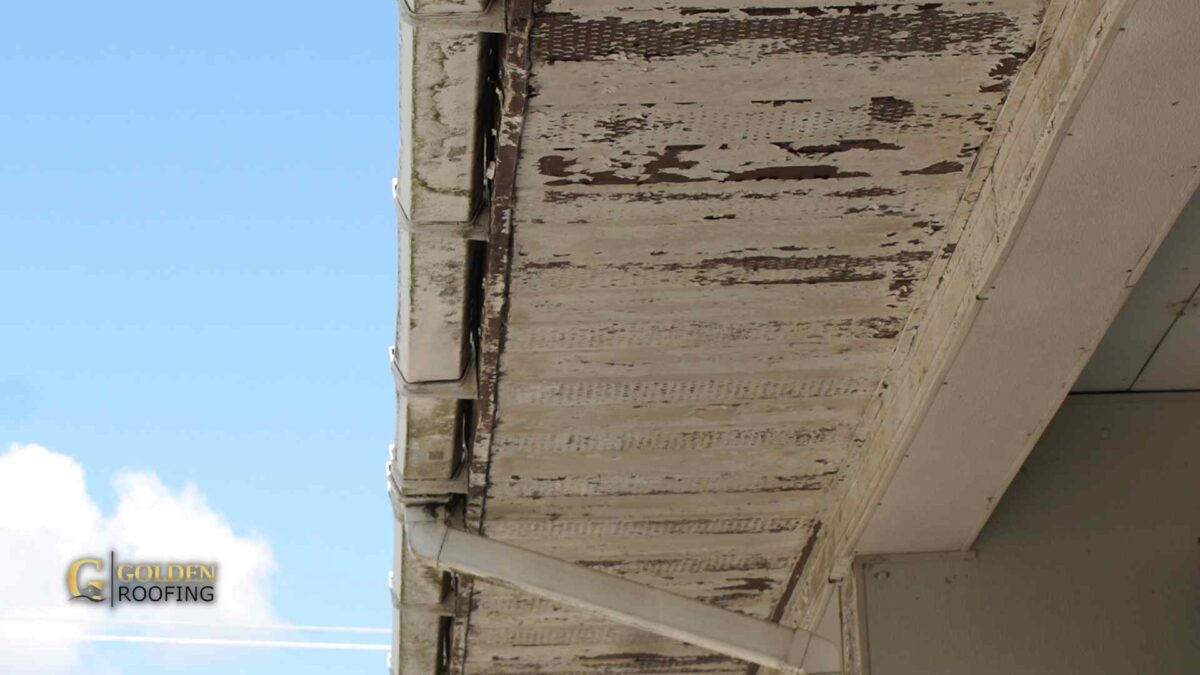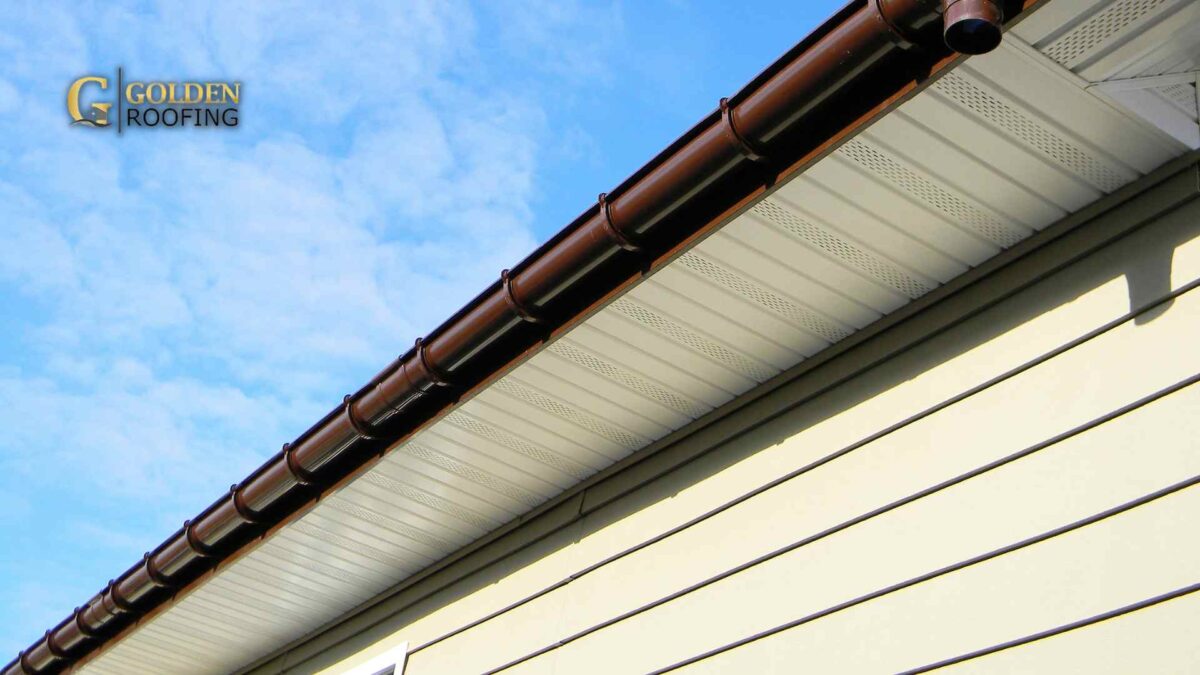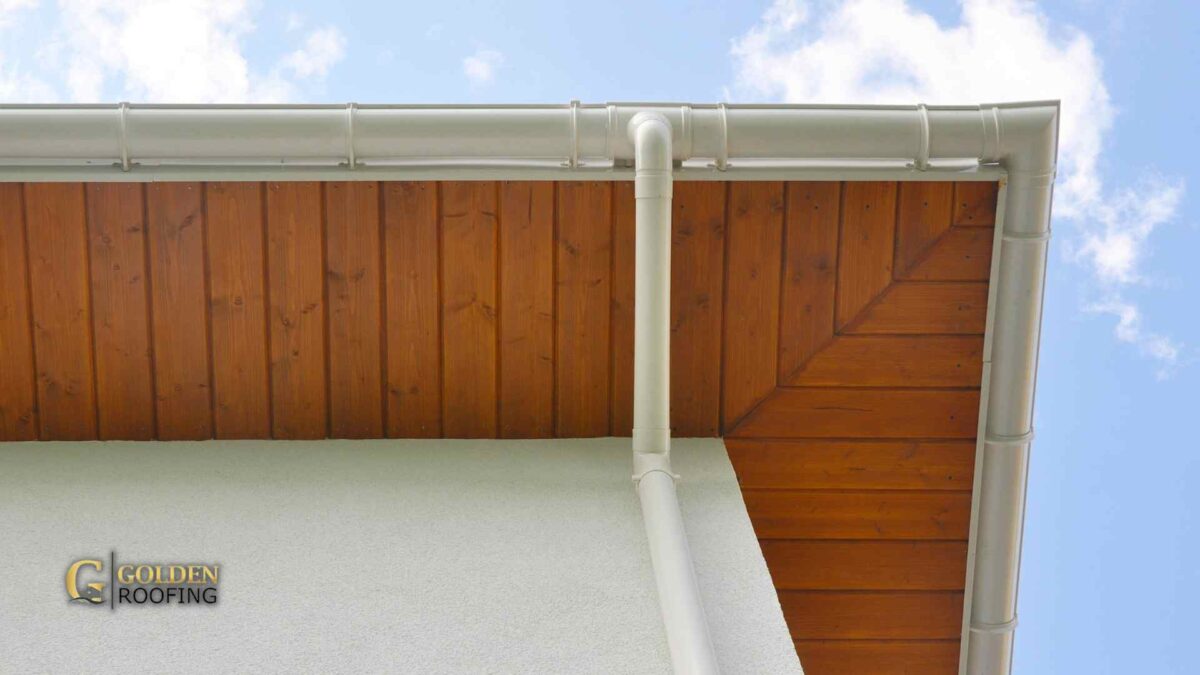Preserving your home’s structural integrity and visual appeal often entails meticulously examining those frequently overlooked components. The soffit, the element that bridges your roof’s overhang, is one such component. Similar to all other components of your roof, this element can sustain damage from the elements, necessitating soffit repair or eventual soffit replacement. The soffit replacement cost varies depending on the material used and the length of your soffit.
However, most homeowners can expect to pay between $6 and $20 per linear foot for professional installation. At Golden Roofing, our experienced roofing contractors handle all roof repairs, replacements, and installations.
Understanding Soffit and Its Importance
Before diving into the specifics of soffit replacement costs, it’s crucial to understand what soffit is and why it’s so important for your home.
What Is Soffit?
Soffit is a roofing element that aids in ventilating the attic by allowing airflow, which helps to disperse heat and moisture that can accumulate and potentially cause rot in the rafters and sheathing.
Soffit boards also add a finished look to a building, concealing the underside of the roof overhang and providing a clean, polished appearance.
The Connection Between Soffit and Fascia for Roof Health
A fascia board is a vertical finishing edge connected to the ends of the rafter tails or trusses, typically where gutters are installed. It acts as a protective barrier, sealing off the roof’s edge and preventing moisture, pests, and other outdoor elements from entering the roof and attic space.
The soffit, installed beneath the fascia board, extends from the side of the building to the edge of the roof’s eaves.
Together, the two enhance the aesthetic appeal while maintaining a balanced attic environment, supporting the gutters, and protecting the roof’s structural components against weather and wildlife intrusion.
Benefits of Replacing Soffit and Fascia Boards
Replacing soffit and fascia boards brings multiple benefits. New soffit boards improve ventilation, reducing moisture and mold for better air quality. Fascia boards enhance structural support for roof edges and help protect rafters from weather elements, maintaining the roof’s integrity.
Soffit and fascia replacement improves energy efficiency, aids pest prevention, and raises curb appeal and property value while performing the necessary task of directing water away from the home.
How to Know if Your Home’s Soffits are Damaged

From visual cues to more subtle indicators, understanding the signs of damage ensures you can take timely action to protect your home’s exterior from further damage.
Common Causes of Soffit Damage
Common causes of soffit damage include:
- Water Damage: Water damage often occurs from leaking gutters, ice dams, or roof leaks, which leads to rotting or warping in the wood boards.
- Animal and Insect Infestation: Small animals, birds, and insects like bees or wasps can find their way into soffit vents, especially if there are gaps or existing damage.
- Poor Ventilation: If the attic isn’t adequately ventilated, moisture can accumulate, leading to rot or mold.
- Aging and Sun Damage: Exposure to extreme weather conditions like strong winds, heavy rain, and sunlight can speed up this deterioration, leading to cracks, fading, or brittleness.
When Should You Replace Soffit?
You should consider scheduling a soffit replacement if you notice signs of damage, such as cracking, flaking, or rotting material, particularly with wood fascia or soffit.
Fascia Boards: An Integral Part of Roofing
Understanding the part fascia plays in the overall roofing system can help homeowners understand its significance, especially when it’s time to justify fascia costs to replace fascia boards.
Role of Fascia Boards in Roofing
Fascia boards create a smooth, straight appearance, enhancing the home’s exterior look. Fascia is key in supporting the lower edge of the roof tiles or shingles and providing a solid attachment point for gutters. Fascia board replacement helps in proper rainwater drainage, reducing the risk of water damage to the roof structure and walls.
Common Damages To Look Out For
Here are some common types of damage to look out for in fascia boards:
- Rot and Decay: Constant exposure to moisture can lead to fungal growth, causing the wood to rot, which weakens the fascia board and can potentially lead to structural failures.
- Cracking and Splitting: Exposure to harsh weather conditions can cause wood or vinyl fascia boards to crack or split. These damages not only affect appearance but can also compromise the roof’s structural integrity.
- Peeling Paint: If the fascia board shows peeling or flaking paint, it’s often a sign of exposure to moisture and the elements. Peeling paint not only affects the fascia’s aesthetic appeal but can also be an indicator of deeper moisture-related issues.
- Water Damage: Look for signs of staining or soft, spongy areas on the fascia boards, as these are indications of water damage.
- Insect and Pest Damage: Termites, carpenter ants, and other insects can cause significant damage to wooden fascia boards. Holes, sawdust-like debris, and visible insect activity can be signs of an infestation.
How Do Soffits and Fascia Board Work Together?
Soffit and fascia provide a finished look to the roofline and help protect the roof structure from the elements while allowing adequate ventilation. They work together to prevent rot, mold growth, and structural damage.
Common Materials Used in Soffit and Fascia Construction

Wood, vinyl, and aluminum are commonly used to replace soffits or fascia.
Each material type has specific benefits and potential drawbacks, with factors like climate, home design, and material cost considerations playing a crucial role in the selection process.
The Durability of Wood Soffit and Wood Fascia Boards
Wood soffit and fascia boards have a timeless appeal and are valued for their natural aesthetic, but their durability can be a concern if not properly maintained. However, regular maintenance, like painting, sealing, and prompt repairs of any damage, is essential to extend the life of wood fascia and soffit.
Advantages of Vinyl and Aluminum Soffits and Fascia
Aluminum and vinyl soffits and fascia boards offer several advantages for homeowners looking for a durable option that requires minimal maintenance.
Vinyl is not only cost-effective but is also resistant to rot, decay, and insect infestations. Its versatility in color and style allows easy customization without needing to paint. Also, vinyl’s ability to withstand weather-related wear and tear with less maintenance makes it a practical choice for many homes.
Aluminum is highly resistant to corrosion and rust, making it an ideal choice for homes in coastal or harsh weather environments. It’s also lightweight, making the installation process easier, and can be painted to match any exterior décor.
Both materials provide long-lasting solutions that help maintain a home’s structural integrity and aesthetic appeal with considerably less maintenance than traditional materials like wood fascia boards.
Choosing the Right Material Type For Your Climate
Choosing the right material for your soffit and fascia largely depends on your area’s climate and will affect the fascia and soffit replacement cost.
Most homeowners in humid or rainy regions prefer vinyl or aluminum soffit and fascia due to their resistance to moisture and decay.
Wood boards can provide the necessary durability against thermal expansion and contraction for homes in regions with extreme temperature variations.
Breaking Down Fascia and Soffit Replacement Cost

The cost to replace fascia or replace soffits can be complex, with several factors influencing the total cost. From the material cost to labor cost and regional variations for the cost per linear foot, understanding these cost drivers can help homeowners budget effectively and make informed decisions.
Labor Costs Across Shreveport, Monroe, Minden, and Ruston
Labor costs often take the biggest chunk of the total cost of soffit and fascia replacement. Generally, labor costs range between $1.50 to $3 per linear foot for soffit replacement and $6 to $20 for fascia replacement.
However, these amounts can vary based on other circumstances surrounding the replacement. Factors like the material prices, region, project complexity (such as eave configuration or amount of exposed siding), and the roof’s current condition can all affect the labor cost.
Material Costs: Wood Soffit and Fascia vs. Alternatives
When choosing the soffit and fascia board replacement material, it’s also important to compare the cost per linear foot for roofing materials:
- Wood cost per linear foot: $1.50 to $4.50
- Aluminum cost per linear foot: $2.00 to $3.50
- Vinyl cost per linear foot: $1.00 to $2.00
Additional Cost Factors to Replace Soffit and Fascia
When replacing fascia boards and soffits, additional costs need to be considered when budgeting. These include removing the existing materials and replacing other materials like gutters and drip edges.
Disposal Fees
The disposal costs of removing the old soffit and fascia materials usually cost $1.00 to $2.00 per linear foot. Removing and disposing of the existing materials are often already part of the overall cost, but verifying that with your roofing contractor is important.
Necessary Repairs or Upgrades
When your roofing expert evaluates the soffit and fascia damage, they might also find other necessary repairs or upgrades. If the damage to the roof goes deeper than the soffit and fascia, you could incur additional expenses for leaks, new gutters, roof caps, and flashing repairs.
DIY vs. Professional Soffit Replacement
A DIY job can cut costs, but it demands a good skill set, proper tools, and awareness of safety measures due to the heights involved.
However, while more costly, professional installation provides expert craftsmanship and efficient completion. A job performed by a reputable roofing company will typically come with a warranty.
The Risks of DIY Soffit Replacement
Working at the heights required for fascia and soffit replacement can be extremely dangerous, especially if safety measures aren’t taken. This is a risky DIY project and can be very time-consuming for those with limited experience.
Plus, if a homeowner makes any mistakes during the replacement, they may need to call a professional, which negates the whole idea of trying to save money in the first place.
Preparing Your Home For Soffit Installation or Replacement

Preparing your home for soffit installation or replacement is essential to ensure the process goes smoothly.
Steps to Take Before Soffit or Fascia Replacement Day
To prepare for soffit installation or replacement, clear the area around your home for easy and safe access, trim nearby overhanging foliage, and, if necessary, remove items from attic spaces to avoid damage.
Setting Expectations for the New Soffit and Fascia: Timeline and Process
The installation process depends on the house size, complexity of the architecture, and weather conditions. A professional roof inspector can usually provide a more accurate timeline after assessing the site.
The more homeowners can prepare their homes for the soffit and fascia installation, the more it can help contractors once they start work.
Golden Roofing: Your Partner for Soffit Replacement and Soffit Installation in Monroe, Shreveport, Bossier City, Minden, and Ruston, LA
If you’ve noticed some areas along that could use some TLC, a roofing expert at Golden Roofing is ready to help. Complete our online contact form to schedule a free estimate to determine your fascia or soffit replacement cost!


